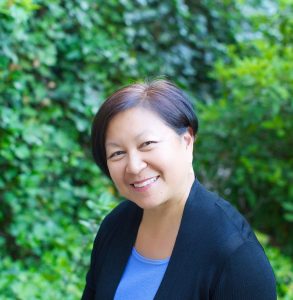Alice Sung — Principal, Greenbank Associates

Alice is a recovering architect of over 25 years, currently leading the green building and sustainability consultancy she founded in 2004. She spends much of her time advocating for public K-12 schools to promote healthier learning environments for our children, and for shifting utility operating dollars to educational programs. Championing sustainable schools for two decades, she has facilitated the greening of dozens of public buildings and has served in leadership positions for many professional organizations. Her undergraduate degree in Architecture is from UC Berkeley; her Master of Architecture is from MIT.
In 2018 she trained with The Climate Reality Project to help spread awareness of the urgent, global climate crisis. Working as a change agent, she is passionate about transitioning new — and especially existing — buildings to zero energy/water and now zero carbon, at pace and scale.
While sheltering-in-place, two favorite pastimes are dancing and painting.
What is the educational and career path that led to your current career?
When I started my professional education in architecture there were no programs in sustainable architecture or environmental sustainability, so I didn’t start out to become a ‘green’ architect. But I was always interested in the human aspects of design, those based on public service for the common good through energy efficiency and natural resources conservation. Shortly after programs such as CHPS and the LEED rating system began, I completed one of the first green schools in California, the CHPS-rated Cesar E. Chavez Education Center in Oakland. I was both hooked and ruined at the same time, because I couldn’t go back to doing business as usual designing ‘non-green’ schools.
What environmental issues are of most concern to you?
Currently there are several, all related to climate change and the UN Sustainable Development Goals (SDGs). These include:
- The 2018 IPCC Special Report highlighting the critical goal of keeping warming less than 1.5°C above pre-industrial levels (BEFORE 2°C!) by 2030 in order to avoid the worst impacts of climate change.
- Globally, buildings are responsible for 40% of our greenhouse gas (GHG) emissions. In California they represent 25% of state emissions.
- Thus we need to greatly reduce both our operating and embodied carbon emissions from both new and especially existing buildings to zero as soon as possible.
- To meet science-based imperatives, all new buildings need to achieve zero net carbon (ZNC), while all existing buildings need:
- Deep energy retrofits to transition off natural gas usage;
- Replacement with new, more efficient electric technology;
- To power everything with 100% renewable clean energy.
What inspired you to start your business and how did you take the leap to start it?
I was inspired to leave architectural practice to start my own green building/sustainability consulting firm due to a number of factors. Having worked at architecture firms, all led by men and none of whom were leaders in sustainable design, I felt compelled to follow my own path. I learned a lot from my first few ventures into green buildings and rating systems development, but wanted to dedicate my work solely to creating more sustainably designed buildings. Since there was only a handful of green building consultants at the time, I took the leap of faith.
Later, I combined my technical background in energy efficient, ZNE buildings with sustainability certification through the ISSP, leading to a natural progression in my professional journey. Realizing my purpose was to maximize carbon emission reduction, my services expanded to include all aspects of organizational sustainability consulting, from carbon footprinting and climate action planning/reporting, to green building programs, and more.
What are your suggestions on how WEN members can become more involved in your sector of the environmental movement?
WEN members have a huge opportunity to become more involved in the movement. Everyone can affect the transition away from fossil fuel energy use in our homes, workplaces, schools, and other buildings we frequent or support. Here are three examples:
- In homes we can improve indoor air quality, reduce utility bills, and lower our carbon footprint by switching out natural gas appliances for space and water heating with 3-4 times more efficient electric heat pumps. Replacing gas ranges with all-electric induction ones also helps!
- At workplaces we can organize green teams to recycle and conserve energy and water. If you are an owner, develop a baseline GHG inventory and invest in sustainability planning to save on operating expenses.
- In neighborhood schools we can support energy efficiency as well as decarbonization to transition natural gas use to electric heat pump technology, and provide solar plus battery storage for community resiliency.
For more information, or to connect or collaborate with Alice, you’re welcome to reach out to her personally on LinkedIn.
